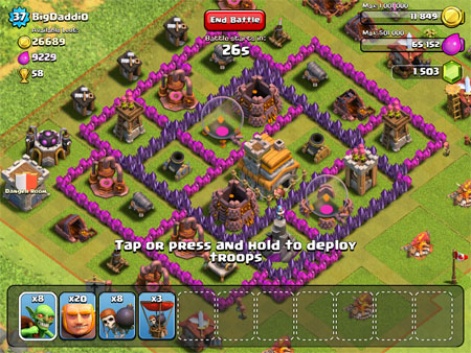Its easy to think on Twitter that free to play is one of those things that you must either love or loathe - if you're not for it you're against it and vice versa.
Making a comment either way seems a sure fire way to trigger a heated debate.
Personally I'm ambivalent. I don't think free to play is inherently evil, but at the same time, I've not (up till now) really enjoyed a F2P title for any length of time. In fact, I have far more paid than F2P games on my mobile devices.
However, over the last six months, Clash of Clans has begun to demonstrate to me how freemium can be really become part of the game design.
Cash of Clans
Clash of Clans is, of course, a fantastic game on many levels, and I reckon only a real stubborn F2P hater will find nothing to like about it.
There are many aspects I love about it - I like laying out my village trying to get a perfect, impregnable arrangement of defences. I like seeing my little warriors sitting round their camp fires. I like the minimum-communication-necessary multiplayer.
I like it so much that I've been playing for over six months and it's become the only F2P game I've ever monetised - £2.99 to date, which is equal to the highest priced premium game I've bought on mobile and I've played it a heck of a lot more than that title.
I may even put another £2.99 in someday.

Clash of Clans
Several commentators have already examined why Clash of Clans is a great game in depth.
The stand out thing for me as a game designer is how the premium currency works not just as a pay wall, but as a proper game system that intersects with, not disrupts, the other game mechanics.
Mixing it up
Game design boils down to having a collection of systems that overlap with each other to create an experience that yields predictable results, but analogue outcomes.
For example, in a shooter, the systems governing weapons, aiming, ammo, AI and environment come together to create a game where I can predict the range and direction I will fire in when I hit the trigger, but the actual result of shot hit, fatal headshot, miss is analogue collusion between all those systems at the moment I fired.
Therein lies the fun, depth and progression of a game.
With F2P games I've played previously, the premium currency options have appeared rather digital pay, or don't pay. In contrast, Clash of Clans's use of premium currency (better known as gems) feels far more analogue.
Of course, I can directly pump gems into buying an item I don't have the resources for or instantly completing a time-based task. Or I can simply wait for free. But, there is also a third option, and that's to combine the two.
The number of gems I need to put in to buy or complete an object goes down according to how much of the soft currency I have available or (in the case of time) have already put in.
Rather than pay 500 gems or wait eight hours, I can choose to wait six and a half hours and pay 150 gems. Or raise three quarters of the necessary gold and subsidise the rest of the price with gems.
Multiplayer madness
This gets more interesting when it interacts with the multiplayer system.
A player attacking you can always steal a certain portion of your resources, but if they are victorious your shield will activate automatically for a set time. Whilst your shield is active, your resources are quite safe.
Now, lets say whilst my shield is active my gold mines have raised 90 percent of the cost of an upgrade. When the shield deactivates, I can take a decision to subsidise the remaining 10 percent with gems, or wait and take the risk another player steaming in and nicking some of that gold I've just made.
Plus, since I can use gems to manually activate my shield, it may be more efficient to do that and let my gold and elixir mines do their thing for 24 hours than to put the gems directly into buying objects.
Then again, I can use just a few gems to boost my mines' output which, if my shield has activated automatically, may be the best option. Or I can convert gems to resources. And all of this is dependent on how far I've levelled up the various parts of my village.
Different by design
The upshot, anyway, is that I have far more options with my premium currency than a simple pay or don't pay choice, and the outcome of those options changes analogue to how the game's other systems are affecting my game world at any particular time.
It all means that, yes, you can go in and mindlessly blast a load of premium currency willy nilly. But, with a little planning and skill, you can make a few gems go a very long way. The use of currency becomes a form of gameplay in itself.
Deciding how best to use my premium currency is something I enjoy in Clash of Clans finding an especially efficient way of spending it to unlock an upgrade gives me the same kind of thrill as day trips to London when I make lots of journeys and get my money's worth out of a one day Travelcard - and yes, okay, I am a cheapskate.
I don't feel like I've somehow cheated or copped out of the real game by monetising (as I think many core gamers tend to feel about putting money into a F2P), but more like I'm spreading the cost of a game I enjoy over the time I'm playing it.
It is not perfect of course, but for me this is the game which has really started to put that often lofty sounding promise of freemium a business model that removes barriers for new players and lets fans enhance their game by monetisation - into practise.






















